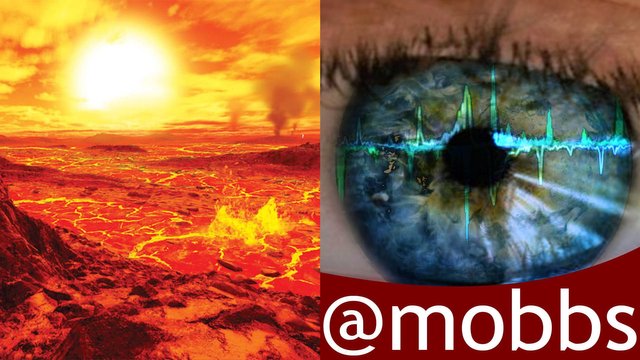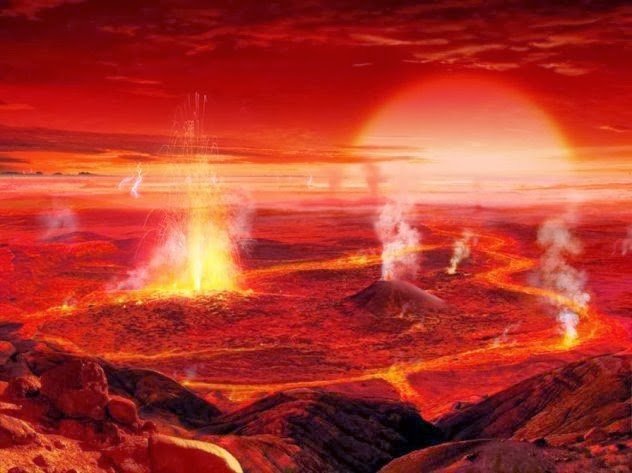I think I just found Hell: The devastating weather discovered on exoplanets Corot-7b & HD 189733 b


Earth has historically been a pretty rough
That is, if you have no comparison. Once we start looking outside of Earth, we should have nothing but gratitude. This exoplanet episode is dedicated to the weather observed around the Galaxy, as a harsh reminder of what life out there has to contend with.
Corot-7b: Straight out of Doom
This planet 489 light-years away was the first ‘potentially rocky’ planet discovered outside of the solar system. And it is not a friendly planet. At all. It is very likely that, just like in my previous post, it is tidally locked. This means one side is always facing the sun and the other side, never.
Last time I explored how this kind of planet could be an interesting place for life to reside, setting up shop in the band around the earth between two extreme faces.
Corot-7b is… not so lucky.
This is because its orbit is really close to a star not dissimilar to our own – much larger than the ultra-cool red dwarf Trappist-1. With a distance of barely 2.6 million km, the planet orbits 22 times closer than Mercury does around our Sun.
It is possible that this planet is what we call a Chthonian planet. A Chthonian planet is one that would previously have been described as a ‘hot Jupiter’, but has since had its atmosphere entirely stripped away by extremely close distances to the sun and its powerful radiation. Chthonia happens to be a suitable name for more than one reason, however.
Being so close to a hot star, the face of the planet directed at the sun is not only hot, but 2,600°C hot. This is hot enough to completely vaporize rock.
The far side could be much, much cooler, as low as -222°C.And what do extreme differences in temperature create? Wind! And lots of it.

Not a real photo
Of course, that’s only provided there is actually an atmosphere to create wind in the first place, and I already said it was probably stripped away. But luckily for Corot-7b, the temperature is so extreme that the entire surface is very likely molten rock – lava. This global lake of lava produces vapour that rises into a new, molten atmosphere of silicates.
When the harsh Lava winds blow over to the cool side, the molten silicate, like vapour water on earth, condenses and sticks together, solidifying or forming lumps of magma. This congealing and cooling causes it to rain down onto the earth below, where it rejoins the horrifying cycle of death.
But there is an upside. There is an abundance of Oxygen! Since Oxygen is the most abundant element in rock, when it vaporizes, it releases a whole bunch of the life force for us all to enjoy on an exoplanetary vacation. Who’s with me?
No?
Ok, how about my next planet. No raining rocks here:
HD 189733 b: A little more tame?
This planet is much closer to home at barely 63 lightyears away, or 600,000,000,000,000km away. That’s nothing compared to Corot’s 4,645,000,000,000,000km trek.
This planet is a gas giant 13% larger than Jupiter that still manages to hold on to its atmosphere, which shows that it’s much friendlier than C.7b, with a tepid temperature of only 1540۠°C -–Breezy by comparison! (Disclaimer: Also ranges up to 3,300°C, hotter than...yeah)
Its orbital period is only 2.2 days, which may sound extreme, but compared to Venus, where its day is longer than its year, it’s not so extreme. Besides, think of all the Summer vacation’s you’d get. To achieve such a short year, the planet does have to be somewhat close to the star, as well as travel at 252km/s, compared to earth’s 30km/s orbital speed.

To add to my confidence that we should all visit this planet together, it’s already one of the most scrutinized exoplanets out there. It was the first planet to be detected via polarimetry (a technique of measuring optical activity of compounds), which reliably determined that it is a deep blue colour planet, similar to that of Earth.

It was also the first to have a complete thermal map constructed, to have its transit followed via X-rays, and the first to have Carbon Dioxide detected in its atmosphere.
Also quite wonderfully, they detected Magnesium Silicate (MgSiO3) in the atmosphere, or Talc. You know, soft baby powder. How delightful!
Ok, I know you’re already packing, but there are a few caveats. Due to the planet also being landlocked, the temperature difference again creates strong winds. In fact, 8,700 km/h winds, or 15 times faster than the speed of sound.That’s so fast that the rain on this planet falls sideways. And…the rain is made of shards of hot glass.
What?
Yeah… Magnesium Silicate is also the main components of sand, which melts at 1900°C, and in this planet, it evaporates into the atmosphere. Just like C.7b, the wind whips it around to the far side where it cools, congeals together and forms liquid glass, which then drops back down into cooler layers of atmosphere, solidifying into glass shards. Which then perpetually zoom around at supersonic speeds into… my face.
Ok, this planet is starting to sound much, much worse than C.7b
But there is water vapour, Oxygen and Methane, just like Earth!

Ok, so some planets are destined to be devoid of all life. Fine. But that doesn’t mean they aren’t amazing and it certainly doesn’t mean we can’t learn from them. These planets are teaching us a whole range of things, like how to get glass in your face and how to melt your umbrella.
Eventually, we will find one so suitable for human life, it will be hard to resist a visit. I just found another great contender, OGLE-TR-56b, looks good so far, although it does… rain molten Iron.
Urgh, I’ll leave it to the real scientists.

Image Sources:
Boring Earth weather
Blue Planet
Thermal Map
Drawing of C.7b
Idk... Go to Corot-7b! doesn't sound as catchy as go to hell.
I dunno, it's starting to grow on me. C7B could be internet slang...? Or maybe I just don't know what the cool kids like these days
Raining molten iron sounds like rough vacation weather. Thank you for the post super interesting.
Well, that should make for some entertaining parasailing. When are we leaving?
As soon as you're ready but... you first. I'll follow
Wow !
Interesting and mind blowing post.
👍👍👍👍👍👍👍👍👍👍👍👍
Upvoted !
Great series of posts, keep 'em coming! :)